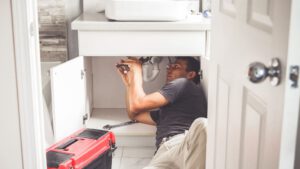Signs That Your Plumbing Needs a Plumber
As a homeowner, it’s important to watch for signs that your plumbing needs repair. Plumber Northridge spots these issues early and deals with them quickly before they escalate into larger problems.
Some of these issues have easy at-home fixes for homeowners, but a plumber should only tackle others. Here are some of the common plumbing repairs that plumbers do:

Clogged toilets are perhaps the most common reason for a home to require a plumber. They can cause significant drainage problems if not addressed quickly, leading to sewage backups and other issues that affect your health and well-being. Luckily, many clogged toilets can be repaired with basic tools and knowledge. However, you should always call a plumber if your toilet is overflowing or the drain is emitting foul odors.
Clogs are often caused by flushing things down the toilet that should not be there. While children are notorious for this, adults can also be guilty of it. It’s important to make sure that only toilet paper and waste go into your drains, and not items like q-tips, cotton balls, food wrappers, or feminine hygiene products. Many of these products are marketed as “flushable,” but they can lead to blockages in your toilet and pipes if they aren’t flushed properly.
When you experience a clogged toilet, the first thing you should do is try plunging it. If this doesn’t work, you can try a few other basic methods before calling in a professional. If you have a clogged toilet that’s constantly overflowing, turning off the water in your home may be necessary before you call a plumber.
Other signs of a clogged toilet that you should look out for include an unusual gurgling noise, or the appearance of standing water in the bathtub or shower. If your toilet is leaking, it can cause serious damage to your floors and walls that require a plumber’s attention.
If your clogged toilet is on the second or third floor of your home, or if it’s causing drainage problems throughout your entire house, it could be a sign that a clog has made it into your main sewer line. This is a more severe problem than one that’s isolated to your toilet and will likely require a professional plumbing service to resolve.
While a plumber can handle any emergency situation that arises, it’s best to prevent these situations from occurring in the first place. Practice good toilet etiquette by being careful about what you flush and limiting how much toilet paper you use, using biodegradable cleaning products in your bathroom to protect your pipes from harsh chemicals, and having your home’s plumbing systems and toilets inspected annually.
Having modern, efficient appliances is not only essential for the comfort and cleanliness of your home but can save you money. Upgrading your old water-using fixtures to ones that meet the Water Sense and ENERGY STAR standards can help lower your utility bills, while also having a positive impact on the environment.
One of the most important water-using appliances in your home is your refrigerator’s ice and water dispenser. These modern conveniences keep you hydrated and cool throughout the year, but can become damaged over time. When this happens, it is a good idea to have your appliance repaired as soon as possible.
After a storm, many homeowners are faced with the difficult question of whether their appliances can be salvaged from flood damage or if they will need to be replaced. While it is certainly impossible to say for sure, there are some helpful guidelines you can follow to help determine if your appliances can be saved.
Depending on the amount of water damage and where the appliances were sitting in your home, you may be able to revive them by removing the water and then using a dehumidifier to dry them out. However, it is always best to have a professional inspect your appliances before trying to repair them yourself.
Plumbers often work with pipes, fixtures, appliances and other tools that facilitate the distribution of water, sewage and waste in buildings. They can install these systems in new construction and renovation projects, and also troubleshoot and repair existing ones.
Frequent leaks, clogs or low water pressure can indicate that the plumbing pipes in your home are deteriorating and need to be replaced. If the problem isn’t dealt with promptly, it can lead to significant property damage.
If a pipe is leaking, it’s important to turn off the water supply valve before you can try to fix the issue. This will prevent water from continuing to flow and cause additional damage. You can also use a pipe cutter to cut out the damaged section of pipe and then replace it with a slip coupling, which is a rubber gasket that fits over the end of the pipe. Be sure to purchase the right size of coupling for your pipe material and that it’s compatible with your water system.
A plumber can also use a trenchless method for repairing a damaged pipe called pipe relining. This process involves making only two holes in your home’s exterior, one at the point where the pipe enters your house and the other where it exits. A flexible felt tube that’s imbued with a special resin is pulled through the damaged pipe and hardens inside, effectively creating a brand-new pipe within your old one.
This method is significantly less invasive than digging up and replacing the entire pipe, which can save you time and money in the long run. However, it doesn’t address issues like poor structure or routing, sagging or other problems that can only be fixed with a full excavation and installation of new plumbing pipes.
A plumber may also suggest pipe replacement if the existing pipes are too damaged or corroded to be repaired with relining or other methods. Pipe replacement can be a more expensive option, but it can offer a higher level of reliability and efficiency for your plumbing system. Plus, you’ll be able to upgrade to a better quality of pipe material that will last longer.
